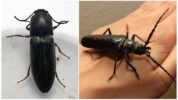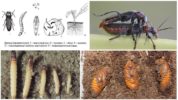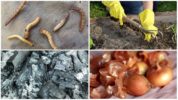- Nutcracker Beetle (wireworm)
- Beetle Development Cycle
- Wirewalking
The beetle is a nutcracker, it is also a crackler - a representative of a huge family with 10 thousand species, divided into 400 genera. The official name is given because of the peculiarity of jumping, making a sound that sounds like a click when the click mechanism is divorced. So the bug flips in the air, assuming the usual position of the body. Translated from Greek, means drover, thrower. Larvae are called wireworms due to their long, thin body.
What does it look like
The wireworm beetle is a typical representative of beetles. The body is oblong, elongated, from a few millimeters to 2 cm long. The chest occupies one third. There are long, even mustaches on the head. Many species have a brown, black color with a metallic sheen, stains, spots throughout the body. A photo of the nutcracker bug is presented below.
A special characteristic that distinguishes the nutcracker from other bugs is the presence of a hopping mechanism. It is formed by the front, middle part of the chest. The wire mechanism sets in motion when it is in the supine position. Initially, it bends the front of the chest, is repelled by the hind legs, flips in the air.
Nutcracker beetle larvae have an elongated body of cylindrical shape. In some species, the caterpillars are almost bare, in others they are densely covered with hairs. The color is dark brown, light yellow. A photo of the beetle nutcracker beetle at a developmental stage is located below. Pupa elongated; body has no durable chitinous cover. Beige, yellow or white.
Interesting!
In Central America, there are species of cod beetle that use bioluminescent glow. Females emit light to attract males, wireworm larvae to attract prey.
Lifestyle
Adults lead an open lifestyle. Most of the time they spend on plants, woody vegetation or hide in secluded places - forest litter, manure, compost pit, wood cracks, bark, stones.
Throughout adulthood, adults do not eat at all or eat the green part of plants. Their main goal is to lay eggs. For one clutch reproduces up to 1,500 eggs, places them in heaps of 5 pieces.
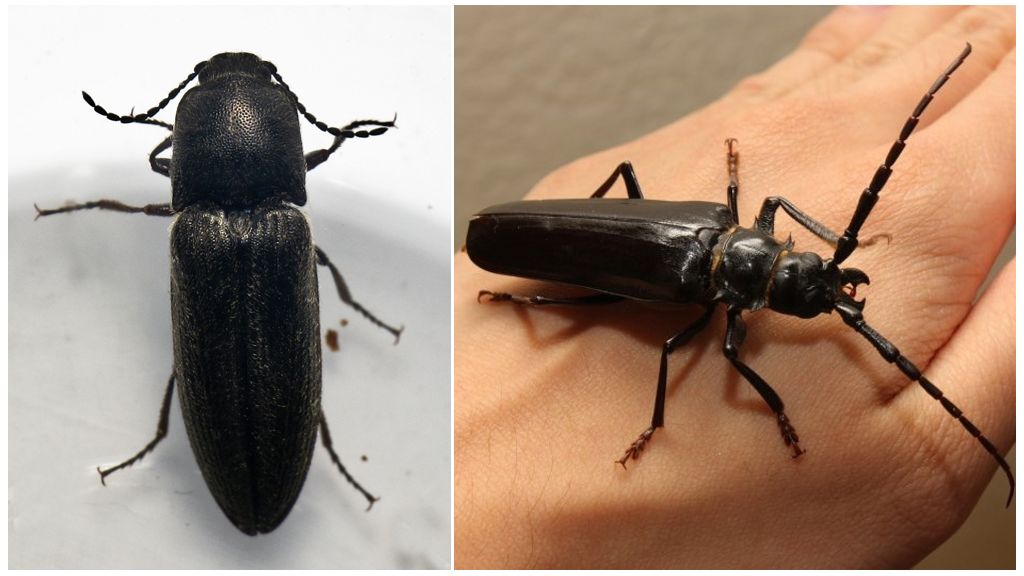
On a note!
Wireworm larvae turn into adults for 5 years. From the second year they turn into real crop pests. Omnivores, feed on root crops, kidneys, roots.
The wireworm beetle chooses acidic soil for laying eggs. Infection of the site occurs due to non-observance of crop rotation rules, improper care of the land.
Reproduction - photo and description of the nutcracker beetle at all stages of development
In early spring, the female lays eggs in the soil, climbing into the cracks. After 28 days, larvae appear. The first stage of their development begins. They live in the earth, feed on small microorganisms. From the second year, root crops, roots, and swollen buds of plants begin to actively eat, thereby causing irreparable damage to crops.
The full development cycle lasts 5 years. In the last year, puberty occurs, the wireworm beetles sneaks into the upper layers of the soil, pupates. A full-fledged insect is published.
On a note!
Favorable conditions for the development of the larva of the nutcracker beetle larvae are high humidity, acidic soil.
What the insect eats
Adults do not eat anything or eat the juices of green parts of plants. They do not cause much harm. The real destroyers of crops are larvae. The thin, strong structure of the body allows them to easily pierce the skin of root crops, roots.
About 750 species of cod beetles live in our area. The diet of each of them is slightly different.
- Wireworms of turf, black nutcracker prefer potato tubers, vegetables.
- Larvae of brilliant, striped beetles eat cereals, sunflower.
- Small nutcracker, sowing eats peanuts, beets, carrots, crops.
- The steppe wireworm damages almost all cultures.
On a note!
Do not disdain insects by weeds. They eat leek and burdock with great appetite. If you do not take proper measures, the pests will destroy completely the entire crop, all the vegetation on the site.
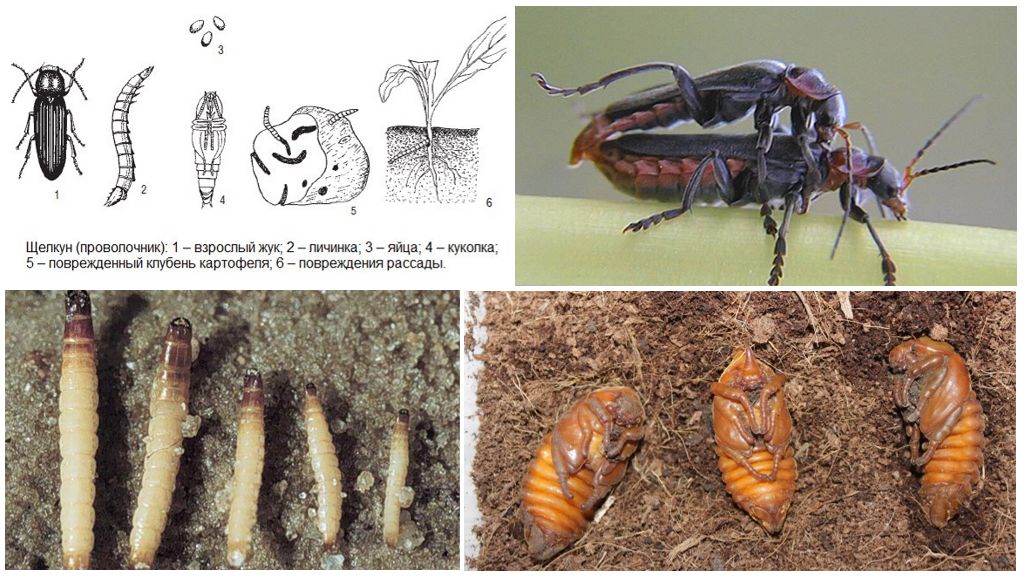
Methods of struggle
To destroy larvae, adults can be different methods, ways. Faster is the desired result with a combination of several.
Agrotechnical methods of struggle
They are characterized by high efficiency, long-lasting action, but the result will have to wait a year or more.
- Dig the soil in late autumn. The larvae, the eggs that are at the top, die from low temperature.
- During the growing season of plants in sunny weather, the soil should be loosened. Larvae do not tolerate high temperatures, die. The same thing happens with wireworm eggs.
- You should not plant a crop for two years in a row in the same place, you need to follow the rules of crop rotation. Bean crops and buckwheat will help get rid of potato from the nutcracker. When planting potatoes, every 3 bushes plant beans.
- If the land is empty for a year, it is recommended to plant it with buckwheat, peas. From such crops, all wireworms crawl to neighboring sites.
- One of the most effective ways to deal with wireworms is to lower the acidity of the soil. Mineral fertilizers, ash, slaked lime, chalk, eggshells are added to the soil.
- During the planting of potatoes, onion husks are thrown into the holes, mustard powder is poured between the rows of beds with beets, carrots.
- Marigolds will help to scare away the nutcracker from the site, if you plant them along the perimeter of the garden, between the beds.
- A few weeks before sowing, oats, barley are planted, then it is removed.
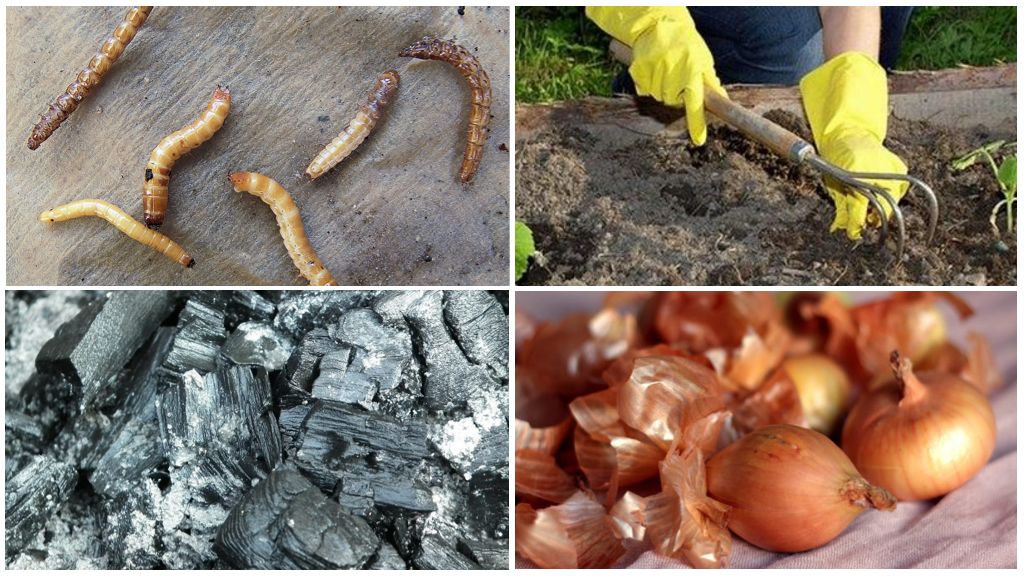
Be sure to remove weed grass, periodically loosen the soil. If it is difficult to fight with agrotechnical methods, you can use insecticides, then follow preventive measures to prevent re-infection of the soil.
Chemical methods
In the garden, potato suffers from the wireworm more than other crops. Insecticidal preparations are used to treat the soil, planting material, and the green part of the plant.
- Prestige. Poison with a wide spectrum of action, lasting effect. The solution is prepared immediately before use. 10 liters of cold water will require 10 ml of the drug. Stir thoroughly for 10 minutes. Potatoes are treated in the solution, allowed to dry, and planted in the wells. The poison is valid for 50 days, after which the insecticide is split, neutralized in the soil. In Prestige, you can also soak the roots of plants, seedlings before planting in open ground or greenhouses.
- Actara. A universal remedy for many agricultural pests. Used to spray the green part of the plant, soil treatment. The solution is prepared extremely simply. 10 ml of the concentrate should be dissolved in a bucket of cold water. Stir well. Water the wells before planting potatoes, beets, seedlings. 10 l of solution is enough to handle 10 square meters. m. garden. Poison is neutralized after 60 days.
- Taboo. An insecticaricidal agent is used to treat seeds, seeds.Apply immediately before planting. 10 ml of the drug are diluted in 1.5 l of water. This amount is enough to process 125 kg of seeds.
On a note!
You can destroy beetles with any poison by spraying the green part of the plant. Traps will help reduce the number of nutcracker bugs. The simplest are placement on the site of half-liter cans or plastic bottles with a cut-off neck. To make the clicker harder to get out, grease the trap with vegetable oil. To attract pests, pieces of carrots and potatoes are thrown to the bottom.
You can meet the nutcracker beetle in the apartment. If the house does not store stocks of vegetables, cereals, there is nothing wrong with the appearance of wireworms. He crawls away on his own or perishes from hunger. Otherwise, he will have to fight. The main method is to carry out a general cleaning, spray the infected area with aerosol based on insecticides. The cereal will have to be thrown away.
